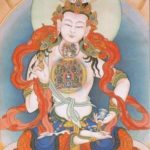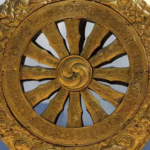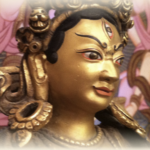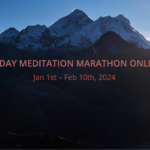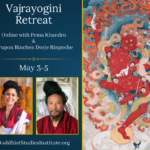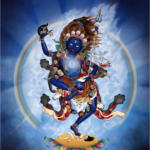One of the tremendous changes to Buddhism in our time is the unprecedented involvement of women at every level of Buddhist leadership and practice. While there have been tremendous gains, there is still much to be done for gender equality to manifest.
Here is my conversation with leading Buddhist women about where we are today and what still needs to change: Pema Khandro Interviews Buddhist Women
There have been a variety of voices for gender equality throughout Buddhist history. In fact, the first women’s rights march was led by a Buddhist woman. Yet at the same time, there are plenty of examples of Buddhist literature that are misogynistic or leave women out altogether. Which one is right? Which one is the real Buddhism?
They are all real Buddhisms. Buddhism is diverse and there have been multiple perspectives on these issues throughout Buddhist history. However, there is a firm philosophical basis for the argument for gender equality.
For example, skandha theory. This is the notion that every person is made up of contingent parts, without a fixed essence underneath. Skandha theory makes it impossible to argue for gender disparities in terms of fixed essences, every person is made up of contingent parts, no of which define the person in the ultimate sense. Since bodies are made of changing components that do not define the person, then biological sex and gendered expression of bodies can’t be taken as the essence of a person.
In terms of emptiness theory, since every person is empty by nature, all persons are equally endowed with the lack of absolute self.
Another example comes from buddha-nature theory. Dzogchen (esoteric Buddhism) says that every person and all phenomena are equally endowed with buddha-nature. Therefore every being has an equal primordial wisdom awareness, even though every being manifests diversely.
Looking through the lens of emptiness, the skandhas or buddha-nature, Buddhism regards binary sex and gender frameworks as constructed, not intrinsic.
Gender, as with every facet of human experience, is a construct, a highly contingent reality.
Some Buddhist literature such as the Vimalakirti sutra offers humorous narratives that exemplify teaching moments where Buddha’s disciples learned about gender equality. In the Vimalakirti Sutra a goddess teaches Shariputra a lesson about reifying gender differences. She asks “What is the difference between you and I?” He answers, “You are a female.” She uses magical powers to exchange bodies with him and asks the same question. Shariputra is stunned, realizing that their fundamental qualities of mind are the same. Other literature such as the Jataka Tales, tell the story of the Buddha’s past life as a woman.
Tied in with gender equality are questions of power in Buddhism, power dynamics in religion and the relationship between Buddhist practice and activism. You can read Pema Khandro’s speech at the historical Women’s March on Washington in 2017, the transcript was published here.
“I believe that not having women priests and women
equally represented at the top ecclesiastical levels
of all religions as one of the greatest human rights issues of our time…”
– Tim Kaine
The push for higher education for women in Buddhist institutions has been a major effort of our time. There are still far fewer female Buddhist teachers, scholars and leaders. Still the movement for gender equality in Buddhism has been promising.
Higher Education for Buddhist Women is an area of new inclusivity. Buddhist women began receiving the highest scholastic degrees of “Khenmo,” in the Nyingma scholastic tradition in the eighties. Its correlate the “Geshema” degree of the Gelugpa school’s scholastic tradition was given to women first in 2017.
Full monastic ordination is now beginning to be available for women. There has been a worldwide movement advocating for full ordination of Buddhist nuns, education and support for Buddhist women all over the world.
In Tibetan Buddhism women have played roles as lineage holders and leaders of the highest rank throughout Tibetan Buddhist history. For example, see Tibet’s first female Tulku is described in this PemaKhandro.org blog post. An important issue for women in Buddhism is recovering such histories of women who were left out of biographies, lineage records and other historical documents. Literary evidence is difficult to come by, but it is there. For example, Pema Khandro’s article on one of the female lineage holders of a major Tibetan monastery here.
Sakyadhita, which means ‘daughters of the Buddha,’ is a major force for positive change women in Buddhism. This is an International Buddhist Women’s movement that cherishes Buddhist teachings and traditions while also working to create positive change for gender equality. You can see photos and articles here – Pema Khandro at Sakyadhita. These photos are from Pema Khandro’s presentation at the Sakyadhita Conference in Indonesia.
Another positive change has been the recovery of literature about Buddhist women by Western scholars. In works such as those by Sarah Jacoby, Holly Gayley and Sarah Harding contribute important histories of Tibetan and Indian Buddhist women.
“Feminism is the radical idea that women are full human beings.”
– Karma Lekshe Tsomo
Tibetan Buddhism’s Yogis, Yoginis and their communities have included more female adepts throughout history. This is in part due to the emphasis on balancing spiritual practice with work and family life. It has also been a non-celibate tradition, with families as the center of lineages. Although women as a whole did not achieve equal social, economic and ecclesiastical, the iconography and philosophy of esoteric Buddhism presented a more inclusive framework. Read Pema Khandro’s article about one of the earliest female Vajrayana masters here.
One of the most recent positive changes for Buddhist women has been ushered in by the #metoo movement, whereby brave voices have spoken out against incidences of misogynistic treatment of women in Buddhist communities in the West. These brave voices have raised awareness of the need for women in leadership in Buddhist communities, awareness of patterns of toxic masculinity in our culture, awareness of gender and sexism as cultural conditioning that we all must overcome. These events have also raised important questions about Buddhism and Sexuality, how these issues have played out historically in Asia and in convert communities in the West. Important actions to follow this momentum up could be making education about Buddhism and Sexuality available to Buddhists to raise awareness and provide positive resources. Also including women in leadership of Buddhist communities so that there is equal representation of women could be another positive step. Another step can be offering greater access to in-depth Buddhist education so students have more resources to ask questions and assertively advocate for their perspectives.
One important basis for a future of gender equality in Buddhism is the presence of Buddhist centers explicitly dedicated to inclusivity, diversity and raising awareness about women in Buddhism. This is the driving motivation by Dakini Mountain Dakini Mountain is the new retreat center we are founding in Northern California close to Lake Tahoe. Read about the importance of Diversity and the gender equality in Buddhism here.
For more reading – Visit this issue of lion’s roar for the first all women’s issue of Buddhadharma Quarterly: Pema Khandro Interviews Buddhist Women
Pema Khandro has lectured on the history of women in Buddhism in Universities and Conferences around the world. Her online course “Women in Buddhism,” covers the history of major figures in India and Tibet, gender issues and special features of Buddhist Tantra. Follow Pema Khandro on Facebook here.
Read the latest news about Pema Khandro and the Buddhist Yogis at PemaKhandro.com
Read about Pema Khandro at the American Buddhist Women E-zine here.

